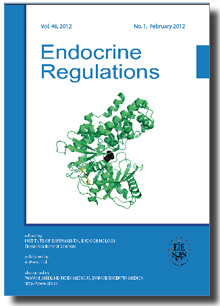Journal info
|
||
Select Journal
Journals
Bratislava Medical Journal Endocrine Regulations 2015 2014 2013 2012 2011 2010 2009 2008 2007 2006 2005 2004 2003 General Physiology and Biophysics Neoplasma Acta Virologica Studia Psychologica Cardiology Letters Psychológia a patopsych. dieťaťa Kovove Materialy-Metallic Materials Slovenská hudbaWebshop Cart
Your Cart is currently empty.
Info: Your browser does not accept cookies. To put products into your cart and purchase them you need to enable cookies.
Endocrine Regulations Vol.38, p.65-79, 2004 |
||
| Title: HORMONAL CONTROL OF PROTEIN GLYCOSYLATION: ROLE OF STEROIDS AND RELATED LIPOPHILIC LIGANDS | ||
| Author: LUCIA MEDVEĎOVÁ, ROBERT FARKAŠ | ||
| Abstract: Glycosylation represents one of the most frequent and certainly the most variable co- and post-translational modification of proteins. Carbohydrate moieties of glycoproteins are known to provide important prerequisites for various biological functions, and their structural diversity can serve as ideal candidate to carry also biological information. Production and/or function of various glycoproteins is under control of steroids and other ligands of nuclear receptors which influence synthesis, glycosylation, storage or usage of target proteins. It appears that among small lipophilic hormonal compounds the steroids are chiefly involved in regulation of protein glycosylation. There is no apparent difference between ability of these hormones to regulate N- or O-glycosylation, but majority of documented cases deals with terminal modifications involving sialylation or fucosylation of N-linked carbohydrate moieties. In spite of the knowledge on glycosylation in general, published results offers only a glimpse of data on the hormonal control of glycosidase activity which is equally required for carbohydrate chain elongation as is the activity of various glycosyltransferases. The significance of this research is daily growing owing to the fact that changes in glycosylation pattern of various intracellular or secretory proteins not only reflect developmental or differentiation stage but also serve as well established markers in invasiveness or regression of numerous cancers responding to hormonal stimuli. Combination of classical methods and more complex approach in genetically well defined model systems can not only increase recent surge of interest in glycosylation but also provide a formidable amount of qualitatively new type of data on the mechanism how hormones control glycosyltransferases and glycosidases and how their activity is interconnected to the synthesis of substrates, posttranslational maturation, and final destination or function of target proteins. |
||
| Keywords: Hormones - Steroids - Thyroid hormones - Retinoids - N-glycosylation - O-glycosylation - Glycosidases - Glycosyltransferases | ||
| Year: 2004, Volume: 38, Issue: | Page From: 65, Page To: 79 | |
|
|
 download file download file |
|

